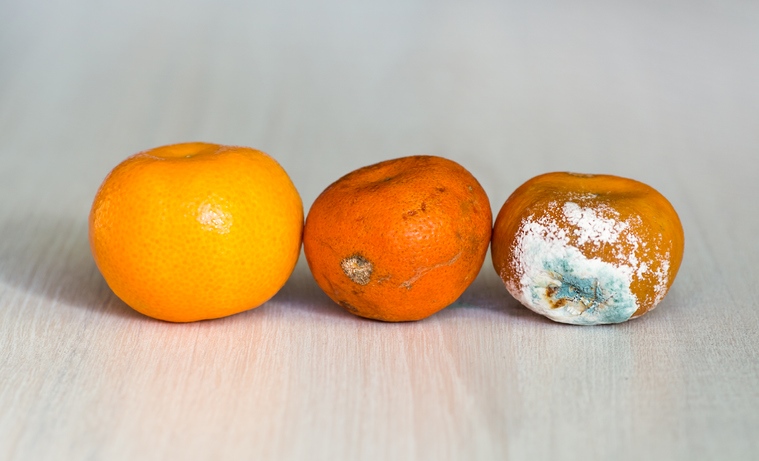
How to tell imperfect produce from spoiled produce
Tips for figuring out if the stuff in your crisper is still safe to eat
Intro
Going to the grocery store will give you the impression that fruits and veggies have to look perfect to be safe to eat, but this isn’t necessarily true. Grocery stores have very high standards for produce; most of the time they only accept the most attractive fruits and veggies, and get it off the shelf shortly after it’s ripe.
This means that plenty of perfectly good produce is thrown away because we take small defects or signs of aging as evidence that it's gone bad. While it’s not wrong to be extra cautious about food safety, it’s worth it to take a look through the tips below to be sure that you’re not throwing away good food (and good money too!).
Generally safe to eat
- Wilting and wrinkling produce
Greens and herbs usually wilt (get droopy), while apples and peppers get wrinkly as they age. This is just a sign that the produce has lost some moisture so it can’t hold its structure anymore. It’s still safe to eat, but you’ll want to eat it pretty soon. You can sometimes revive wilted or wrinkled produce by leaving it in an ice bath for 5-10 minutes. Alternatively, use it for cooking or baking. You won’t be able to tell that the produce started limp after it’s baked or sauteed.
- Scarred produce
Scars are usually caused by physical damage to the skin of the produce when it’s very young. Blowing wind will cause leaves or vines to rub against the tender skin of a young cucumber, and cause tiny tears that heal into scars that become more noticeable as the plant grows bigger. This is cosmetic damage, and completely safe to eat.
- Bruised produce
Bruises happen when fruit is dropped or banged about, which causes soft brown spots. These aren’t dangerous in and of themselves, but they can serve as entry points for other microbes, so you’ll want to cut them off before eating. - Browning on cut produce, like bananas, apples, and potatoes
Some produce turns brown after it’s sliced because of a process called enzymatic browning. Browning happens when the inner parts of a fruit or vegetable are exposed to the air and doesn’t change the quality of the produce at all. If you don’t like the look of it, you can slow it down with lemon juice or refrigeration.
Signs of spoilage, generally unsafe to eat
- Slimy or stinky produce
While a little bit or wrinkling and bruising is usually ok, produce that is slimy to the touch, paler than it used to be, and stinky is probably fully rotten and belongs in the compost.
- Greening on potatoes
Potatoes turn green when they’re exposed to direct sunlight, which causes the potato to produce chlorophyll, the compound responsible for photosynthesis. Green potatoes have a higher level of the chemical compound solanine, a toxin that makes potatoes taste bitter and leads to health problems in large doses. The green skin and sprouts have the highest concentration of solanine, so if there’s only a little bit of green on a potato it’s usually fine to cut off that portion, knock off the sprouts, and peel the skin away before eating. But if a potato is entirely green or tastes bitter, it’s safer to compost it.
To avoid this problem, make sure your potatoes are stored in a cool dark place, out of the sun. - Mould, especially on soft foods
Some kinds of mould are harmless but others produce compounds called mycotoxins that can make you very ill and can’t be destroyed by cooking. The fuzzy mould spots that you can see are only part of the organism. Mould also has very thin, threadlike “roots” which can grow very far into food, and are invisible to the naked eye. This can spread mycotoxins all through your food, even far away from the visible mould.
If you see mould on soft fruits and vegetables with high moisture content, like tomatoes, cucumbers, or peaches, there’s a good chance that the mould has grown throughout the produce. Throw the whole thing into the compost and thoroughly wash any produce nearby to limit the spread of the mould.
It’s much harder for mould to penetrate through firm fruits and veggies with low moisture content, like carrots, cabbage, or bell peppers. These are generally safe to eat if the mould is cut away. Cut at least one inch under and around the mould spot, making sure not to run the knife through the mould, and thoroughly wash the produce before eating.
If you have some slightly damaged produce to use up quickly, check out our discount produce article for suggestions. For advice about extending the shelf life of your produce with proper storage, freezing, blanching and canning, check out our food preservation section. Happy eating!
Futher reading:
USDA. Molds on food: are they dangerous?
Seattle Times. How to know when you need to toss those limp vegetables
Gardening at USask. Scarring on cucumbers and squash
Love food love science. Fruits and vegetables: enzymatic browning

